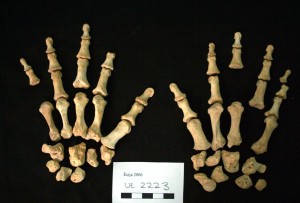Left Handers Day & Lefties: how can we identify handedness (or hand preference)?
Today is (apparently) International Left Handers Day….
There are few lefties among the Archaeology staff… Prof Jon Adams (our UG admissions tutor) for one – he is usually recognizable when diving as the only left handed underwater archaeologist (just see the films of the excavation and lifting of the Mary Rose). More famously (?) Leonardo da Vinci was a leftie. So why is this?
Population-level right-handedness is a defining characteristic of being human. But, despite extensive research, we still don’t know how or when it emerged in human evolution. And anyway, what is right-handedness? Recent doctoral research undertaken by one of the members of CAHO has shown that there are skeletal asymmetries in both arm and hand bones that demonstrate that the right side dominance was present early in the evolution of the genus Homo, and was definitely present by the time that Neanderthals evolved. Dr Lisa Cashmore & Dr Natalie Uomini provided an excellent review of the evidence from tool-use, production, and cave art to confirm that right-hand preference was established in Neanderthals and was maintained until the present. They have also demonstrated that great apes can provide real-life models for the understanding of hand preference. What is particularly noteworthy is that great apes, like humans, do exhibit hand preferences, especially when undertaking complex tasks. Certainly in my own experience, I play cards like a leftie – but am a rightie for almost everything else! Dr Lisa Cashmore has also proposed that when referring to ‘handedness’ it is better to use the terms ‘hand preference’ and ‘hand use’ so as to avoid confusion with different definitions of handedness.
So how do we actually try to assess hand preference in past populations or individuals? Traditionally this has simply been undertaken by looking at the lengths, breadths and cross-sectional morphologies of the long bones in the arms. Where the right side was bigger / longer / wider / had more muscle attachment development than the left side, this was assumed to mean that the individual was a right-hander. But is it as simple as this? Whereas the main focus of previous research on asymmetry and hand preference was on the bones of the upper limb, rather than those of the hand, we decided to study the bones of the hands (the metacarpals and phalanges). To start this research, a method of actually assessing musculoskeletal stress marker (MSM) development in hand bones had to be developed. During her PhD working with me, Lisa Cashmore developed a presence/
absence scoring system was developed for twelve sites of muscle origin and insertion in the metacarpals and phalanges, which was then used to determine bilateral asymmetry in the hands. When we then compared these scores of hand preference with MSM scores from the upper arm bones (humeri) of the same individuals clear differences in the expression of MSM development and asymmetry could be seen between these two parts of the upper limb. Our results suggest that we should not simply continue to use measurements or scores from the humerus as a proxy for the upper limb as a whole and imply that important information regarding behavioural asymmetry in the hands is being lost because of the continual exclusion of this anatomical unit from such research. Instead we need to look at the hands too! Maybe we will find more lefties out there in the bioarchaeological record. #lefthandersday
To read our research, please see:
http://onlinelibrary.wiley.com/doi/10.1002/oa.1254/abstract;jsessionid=48FBDC00E6888549FDA98CD612D4C1B4.f01t02


Leave a Reply